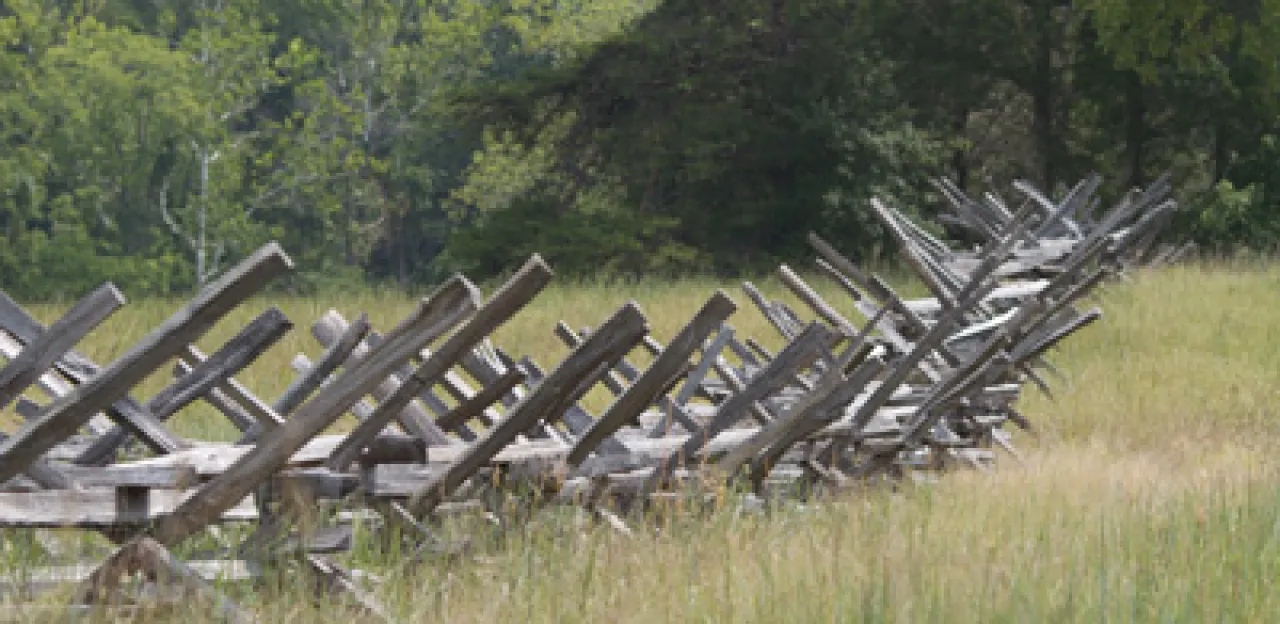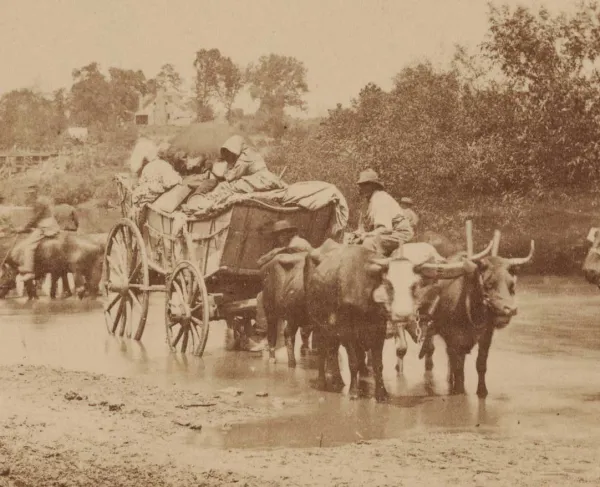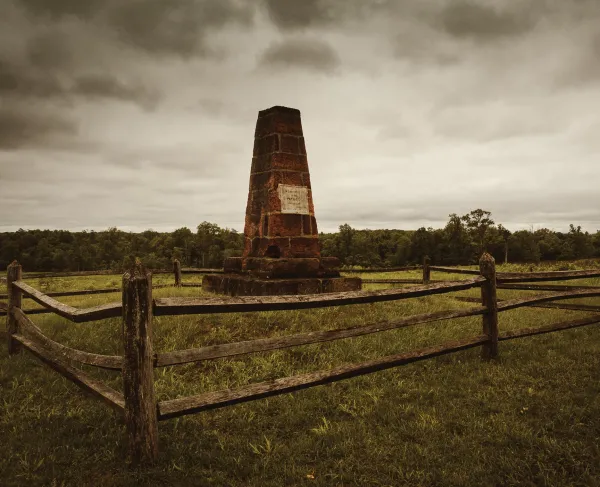Second Manassas: Then & Now

During its 2010 campaign to save 10 acres at Second Manassas, the Civil War Trust had the opportunity to speak with NPS Historian Jim Burgess about the Manassas battlefield.
Civil War Trust: The 1862 Battle of Second Manassas was a much larger and bloodier battle than the 1861 Battle of First Manassas (Bull Run). Why is it then that Second Manassas is so less well known and appreciated today?
Jim Burgess: You're right, the significant yet relatively small first major battle of the Civil War tends to overshadow the larger and more complex Second Battle of Manassas. Part of it may relate to the fact there is considerably more literature available on First Manassas which reflects greater interest and attention by historians. Geography is also a factor. The second battlefield is much more extensive and takes more time and effort to see. The park has tried to address this disparity for many years and we are now offering more programs focused on Second Manassas. We have also opened another visitor center for Second Manassas orientation at the Brawner Farm, but the park's main visitor center/museum on Henry Hill, which focuses primarily on First Manassas, is more accessible and continues to draw more visitor attention.
Set the stage for us. What were the strategic aims of the two armies that fought at Second Manassas?
JB: General Lee was on the offensive, trying to destroy General John Pope's Army of Virginia before it could be further reinforced by McClellan's troops which had been ordered back from the Peninsula. Lee first had to draw Pope away from strong positions along the Rappahannock River. The capture of Pope's supply depot at Manassas Junction by General Jackson on August 27 had the desired effect. Pope saw an opportunity to trap Jackson behind Union lines and ordered his entire army to converge on Manassas. With the knowledge that Lee was on the march with Longstreet's wing to join him, Jackson managed to elude Pope's forces and rested his men in a secluded location near Groveton. On the evening of August 28, Jackson attacked a Union column on the Warrenton Turnpike, revealing his location in a deliberate attempt to draw Pope into battle on ground that now better favored the Confederates. Pope, confident he finally had Jackson cornered, took the bait and on August 29 ordered his army to concentrate on the old Bull Run battlefield. Little did he realize he was actually walking right into a trap.
On the morning of August 29th, Stonewall Jackson’s left wing was isolated and outnumbered. How would you characterize the risks that Jackson faced early in the battle?
JB: Jackson had chosen his position well which minimized the risks he faced. The unfinished Independent line of the Manassas Gap Railroad offered his troops a strong defensive position with adequate cover and concealment. If Pope managed to concentrate his army quickly and press Jackson's line too heavily, escape routes were readily available to the west. However, Jackson was anticipating reinforcements to arrive shortly. Longstreet had broken through Thoroughfare Gap the previous evening and his arrival on the field of battle by 10 a.m. on the morning of August 29 set the stage for Pope's defeat.
On August 30th, General Pope ordered Maj. Gen. Fitz John Porter to boldly strike Jackson’s right. With more than 10,000 union soldiers involved in the attack, why did this massive assault fail?
JB: The attack was supposed to have been made by Fitz John Porter's entire 5th Corps, consisting of six brigades, supported by King's battered division (now under Gen. John Hatch) of four brigades. The total strength of the ten brigades would come close to 15,000 men. Although most of these troops came under fire, only two of Porter's brigades and two brigades from Hatch's division, probably not more than 7,000 men, actually made the assault against Jackson's line. Still, this was a greater assemblage of Union troops than Jackson had seen and repulsed the previous day. The attack came very close to overwhelming Jackson's right. It is well documented that many Confederates resorted to throwing rocks in desperation after running out of ammunition. Jackson's line could have collapsed had it not been for a massive concentration of Confederate artillery posted on a ridge to Jackson's right. Col. S.D. Lee's battalion of 18 guns was situated there along with another battalion of 18 guns that Jackson's Chief of Artillery, Col. Stapleton Crutchfield, had thrown together under the immediate command of Major L.M. Shumaker. This would prove to be one of the few battles of the war where Confederate artillery dominated the field. To reach the Confederate line long the unfinished railroad Porter's men had to cross over 500 yards or more of open ground exposed to this very intense and withering fire the entire distance. For the Confederates it was like shooting fish in a barrel. The Union regiments were simply unable to carry the Confederate position due to the insufficient numbers that made it across Mrs. Dogan's open meadow. In response to Jackson's desperate call for support, Longstreet deployed another battery, Capt. William Chapman's Dixie Artillery, on a knoll near the turnpike. The additional fire from these guns into the flank and rear of the attacking Union lines induced the final retreat of Union troops from the field.
Later on the 30th, General James Longstreet and his "Right Wing" were able to unleash a devastating flank attack upon Pope’s forces. How was it that Pope’s army was so surprised by this decisive assault?
JB: Pope became fixated on destroying Jackson's force and in the process lost sight of Longstreet. On the morning of August 29, Pope had reason to believe that Longstreet's column was still a day's march away. He was still unaware that Ricketts' division had unsuccessfully tried to block Longstreet at Thoroughfare Gap late on August 28 and that Longstreet was in fact about to join forces with Jackson that morning. In his arrogance, Pope refused to believe reports of Longstreet's arrival and deployment south of the turnpike from subordinates he did not trust. Longstreet fed Pope's mistaken beliefs by keeping his men concealed and not joining the battle on August 29. This, however, was mostly out of concern for Fitz John Porter's 5th Corps which was poised to endanger his right flank. By the morning of August 30, reports coming into Pope's headquarters suggested the Confederates were retreating westward. This was enough to convince Pope to remain on the offensive against Jackson. He concentrated most of his available forces north of the Warrenton Turnpike in a final effort to crush Jackson, leaving a relatively small force covering his left flank south of the turnpike. About 4 p.m. Reynolds' division was directed to shift north of the turnpike from its position on the Chinn Farm and cover the retreat of Union troops after the repulse of Porter's attack. This made the Union left even more vulnerable at a critical moment. Only three very thin Union lines remained south of the turnpike to face the 30,000 men that Longstreet ordered forward around 4 p.m.
And here it is that we see James Longstreet leading a highly successful offensive. Seen today as a largely defensive-minded general, has history misjudged Longstreet’s Civil War record?
JB: Longstreet's postwar writings and political leanings tarnished his reputation in the eyes of fellow southerners and this has perhaps contributed to his war record being judged too harshly. During the war Lee had great faith in his "old war horse" and highly valued Longstreet's judgment. On August 29, 1862, Lee deferred to Longstreet's desire not to commit his forces immediately into the battle due to the potential threat posed by the presence of Fitz John Porter's 5th Corps beyond the Confederate right. While Longstreet's massive counterattack on the afternoon of August 30th was successful in driving Pope's left flank back over a mile, it was very costly. The available Union forces put up stubborn resistance. In the span of four hours Longstreet lost over 4,000 men killed and wounded. This was roughly equivalent to what Jackson had lost in three days of fighting. Is it any wonder that Longstreet would henceforth prefer a defensive posture which offered certain tactical advantages?
How much of the First and Second Manassas battlefields are saved today?
JB: Manassas National Battlefield Park protects over 5,000 acres or roughly 90% of the battlefields of First and Second Manassas. There are two residential subdivisions, a private cemetery and a number of relatively small, private residential properties scattered within or immediately adjacent to the park's authorized boundaries. A portion of the battlefield outside the park's southern boundary has been lost to development as a community college campus, business park and a strip mall. The CWPT is currently safeguarding 46 acres of undeveloped battlefield land near Jackson's left flank but outside the park's authorized boundary.
What can one see of the Second Manassas battlefield today?
JB: The park driving tour is oriented around the more extensive Second Manassas battlefield. The first of 12 tour stops on the tour route is the Brawner Farm. Here visitors can get an orientation to the battle and tour the field where heavy fighting erupted on the evening of August 28, 1862. A walking trail leads to the nearby ridge where Confederate batteries were concentrated on August 30. Tour Stop 2, "Battery Heights," marks the position of the Dixie Artillery on August 30 as it helped repulse the Union brigades attacking Jackson's line. The venerable Stone House is the third stop on the tour. This notable landmark, dating to 1848, served as a Union field hospital during the battle. General Pope established his headquarters on Buck Hill behind the house. The tour continues up the Sudley Road to Matthews Hill (Stop 4) and then to the Unfinished Railroad near Sudley Church (Stop 5), not far from where Jackson anchored his left flank. The Unfinished Railroad is also accessible from Stop 6 near the center of Jackson's line. From Stop 7 visitors can follow the path of Fitz John Porter's troops as they attacked Jackson's right in the vicinity of the Unfinished Railroad's "Deep Cut" section. Recent restoration efforts have partially cleared this area of non-historic vegetation so that visitors can get a better sense of what the ground looked like in 1862. A monument erected in 1865 and dedicated in memory of the "Patriots" who perished in the battle still stands near the railroad grade. Stop 8 on the tour is the Confederate Cemetery at Groveton. Some sources suggest as many as 500 Confederate soldiers, mostly unknowns, were re-interred here after the war. A short distance away are three New York monuments along Warren Avenue (Stop 9) which were all dedicated in 1906 by the veterans of the 5th New York (Duryee Zouaves), 10th New York (National Zouaves) and 84th New York (14th Brooklyn). These units all suffered heavy losses in this area. "Hazel Plain," more commonly known as "Chinn Ridge" today, is next on the tour (Stop 10). The foundation of Benjamin Chinn's wartime home can still be seen and a trail along the top of the ridge provides access to the stone marking the spot where Colonel Fletcher Webster of the 12th Massachusetts was mortally wounded on the afternoon of August 30. Webster was the son of the famous orator, Senator Daniel Webster. His regiment was among the Union reinforcements that rushed to the Chinn farm and gallantly tried to contest Longstreet's advance. Stop 11 on the tour is Portici, site of the Frank Lewis farm. The house, destroyed by fire in November 1862, served as General Joseph E. Johnston's headquarters during the First Battle of Manassas but the farm also witnessed a sharp cavalry engagement on the evening of August 30, 1862. John Buford's brigade was eventually driven back across Lewis Ford but not before they had inflicted a stunning blow to Beverly Robertson's brigade on the fields of Portici. It was the largest cavalry engagement of the war until Brandy Station the following year. The last stop on the driving tour is the Stone Bridge where Pope's army retreated after dark on August 30. At the time of the battle a wooden bridge had to be used because the Confederates had destroyed the original bridge when they evacuated the area in March 1862. The Stone Bridge was rebuilt in the 1880s.
What particular challenges does the Manassas National Battlefield face perhaps compared to other Civil War battlefields?
JB: Once rural farmland, Manassas is today situated within a major metropolitan area, only 30 miles from Washington, D.C. Rapid, uncontrolled growth in Fairfax and Prince William Counties has brought commercial and high density residential development to the edge of the battlefield. This urbanization not only has a negative impact on park viewsheds, it also contributes to significant traffic congestion on the public roads that pass through the battlefield. These are the same roads that visitors must use to tour the battlefield. Traffic will often discourage visitors from taking the driving tour of the Second Manassas battlefield. Traffic also invites safety concerns and political pressure to widen the roads through the park at the expense of the park's historic resources. The National Park Service would like to eventually close the public roads to through traffic once alternative bypass routes are in place. However, more road construction in the area could in turn foster more development and generate more traffic, making a trip to the battlefield more arduous. There are no easy solutions.
Looking forward, what improvements would you like to see at the Manassas National Battlefield park?
JB: What I would like to see may not entirely agree with what park planners have in mind. Basically I would want to see the restoration of more parts of the battlefield with less trees/forestation, more accessible trails (wider and better surfaced to minimize erosion but not paved) in more areas, better signage in more appropriate and historically accurate locations, and Second Manassas exhibits integrated back into the park's museum at the Henry Hill visitor center. I am not a proponent of the current concept of having two separate visitor centers, one for each battle, as it is not realistic given available staffing levels, shrinking NPS budgets, and existing visitation patterns. A ban on through truck traffic would be beneficial but I tend to think that closing all the roads in the park to all through traffic is not something that can be realistically attained even with a bypass in place.
Learn More: The Battle of Second Manassas





